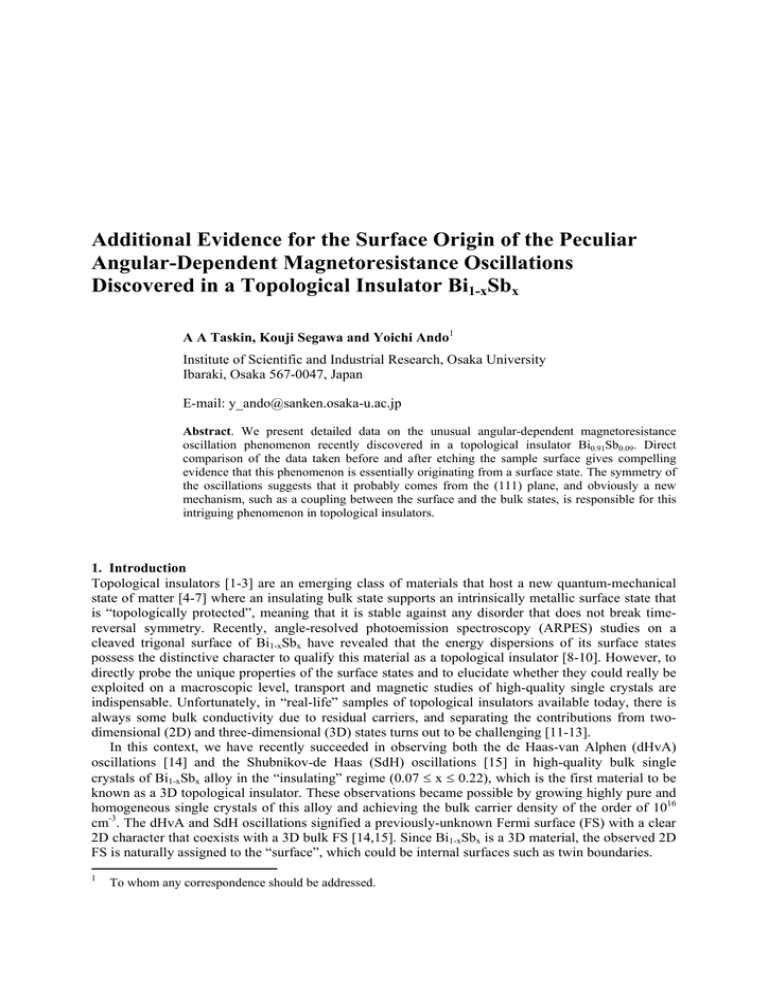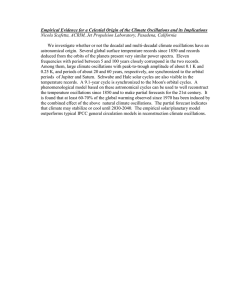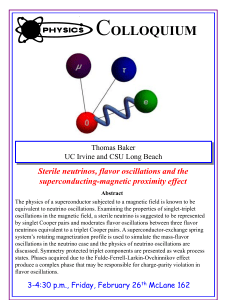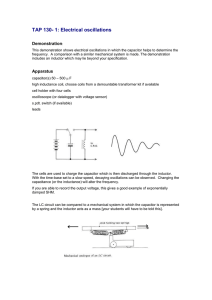Additional Evidence for the Surface Origin of the Peculiar Angular
advertisement

Additional Evidence for the Surface Origin of the Peculiar Angular-Dependent Magnetoresistance Oscillations Discovered in a Topological Insulator Bi1-xSbx A A Taskin, Kouji Segawa and Yoichi Ando1 Institute of Scientific and Industrial Research, Osaka University Ibaraki, Osaka 567-0047, Japan E-mail: y_ando@sanken.osaka-u.ac.jp Abstract. We present detailed data on the unusual angular-dependent magnetoresistance oscillation phenomenon recently discovered in a topological insulator Bi0.91Sb0.09. Direct comparison of the data taken before and after etching the sample surface gives compelling evidence that this phenomenon is essentially originating from a surface state. The symmetry of the oscillations suggests that it probably comes from the (111) plane, and obviously a new mechanism, such as a coupling between the surface and the bulk states, is responsible for this intriguing phenomenon in topological insulators. 1. Introduction Topological insulators [1-3] are an emerging class of materials that host a new quantum-mechanical state of matter [4-7] where an insulating bulk state supports an intrinsically metallic surface state that is “topologically protected”, meaning that it is stable against any disorder that does not break timereversal symmetry. Recently, angle-resolved photoemission spectroscopy (ARPES) studies on a cleaved trigonal surface of Bi1-xSbx have revealed that the energy dispersions of its surface states possess the distinctive character to qualify this material as a topological insulator [8-10]. However, to directly probe the unique properties of the surface states and to elucidate whether they could really be exploited on a macroscopic level, transport and magnetic studies of high-quality single crystals are indispensable. Unfortunately, in “real-life” samples of topological insulators available today, there is always some bulk conductivity due to residual carriers, and separating the contributions from twodimensional (2D) and three-dimensional (3D) states turns out to be challenging [11-13]. In this context, we have recently succeeded in observing both the de Haas-van Alphen (dHvA) oscillations [14] and the Shubnikov-de Haas (SdH) oscillations [15] in high-quality bulk single crystals of Bi1-xSbx alloy in the “insulating” regime (0.07 ≤ x ≤ 0.22), which is the first material to be known as a 3D topological insulator. These observations became possible by growing highly pure and homogeneous single crystals of this alloy and achieving the bulk carrier density of the order of 1016 cm-3. The dHvA and SdH oscillations signified a previously-unknown Fermi surface (FS) with a clear 2D character that coexists with a 3D bulk FS [14,15]. Since Bi1-xSbx is a 3D material, the observed 2D FS is naturally assigned to the “surface”, which could be internal surfaces such as twin boundaries. 1 To whom any correspondence should be addressed. Furthermore, we have extended our measurements to the angular dependence of the magnetoresistance (MR), which was successfully applied to the studies of quasi-2D organic conductors in the 1980s and lead to the discovery of the celebrated angular-dependent magnetoresistance oscillations (AMRO) [16-18]. Intriguingly, in our angular-dependent MR studies, we found oscillatory angular dependences in both the resistivity ρxx and the Hall resistivity ρyx [15]. The oscillations observed at lower fields were elucidated to be essentially a manifestation of the SdH oscillations, whereas the ones observed at higher fields were obviously of novel origin [15]. We proposed that the latter originates from the topological surface state on the cleaved (111) surface of Bi1-xSbx, where the coupling between the surface and bulk states are probably playing a key role in the peculiar MR oscillation phenomenon [15]. In this paper, we present additional evidence to demonstrate that the “high-field” oscillations are most likely due to the exposed surface, by directly comparing the oscillations before and after the sample surface was chemically etched. 2. Experimental High-quality Bi0.91Sb0.09 single crystals were grown from a stoichiometric mixture of high-purity (6N) Bi and Sb elements by a zone melting method. The resistivity was measured by a standard four-probe method on a rectangular sample, where the current was directed along the C1 axis. Continuous rotations of the sample in constant magnetic fields were used to measure the angular dependence of the MR within the trigonal-binary (C3-C2) crystallographic plane. Magnetic fields up to 16 T were applied using a dc superconducting magnet in a 4He cryostat. All the data shown here were taken at the lowest temperature of 1.5 K. To obtain a fresh surface on the Bi1-xSbx single crystals, we applied the following chemical etching procedure: 1) Keep for several minutes in the 1:4:9 mixture of HNO3, CH3COOH, and H2O. 2) Rinse in distilled water. 3) Keep for several minutes in the diluted (50 mol-%) HCl. 4) Rinse in distilled water and dry. 3. Results 3.1. Angular-Dependent MR Oscillations Figures 1(a) and 1(b) show the angular dependences of the transverse MR and the Hall resistivity, Figure 1. (a) Angular dependences of ρxx measured in the trigonal-binary (C3-C2) plane in constant magnetic fields. The dashed line is the MR background ∼ (1-cos2θ) for B = 14 T. Inset depicts the measurement geometry, where θ = 0° corresponds to the C3 axis. (b) Angular dependences of ρyx measured in the same conditions as in (a). The dashed lines are the expected angular dependences of the Hall effect plotted for all magnetic fields. respectively, measured in magnetic fields rotated within the trigonal-binary (C3-C2) plane perpendicular to the current. The magnetic-field strength was kept constant during each rotation. As can be seen in Figs. 1(a) and 1(b), both ρxx and ρyx present an oscillatory behavior as a function of the rotation angle θ. As we have elaborated in our previous paper [15], two different types of oscillations can be distinguished: The first type [though not very clearly seen in Fig. 1] consists of oscillations appearing at lower fields, while the second one becomes prominent at higher fields (B ≥ 10 T). The former “low-field” oscillations were demonstrated [15] to be essentially due to the SdH oscillations originating from the 2D state residing on the (2,-1,-1) plane, which was unambiguously observed in the ρxx(B) data for magnetic-field sweeps in fixed magnetic-field directions. The focus of the present paper is the “high-field” oscillations, which develop on a smooth fielddependent background coming from the anisotropy of ρxx(B) along the different axes. An example of the fitting of the background for B = 14 T is shown by the dashed line in Fig. 1(a). Because of a large MR background in strong magnetic fields, only largest peaks in ρxx(θ) can be clearly seen in the raw data [Fig. 1(a)]. The ρyx(θ) data shown in Fig. 1(b) also present pronounced angular-dependent oscillations at high fields. The “background” for ρyx(θ) is simply the angular dependence of the Hall effect, RHBcosθ, where RH is the Hall coefficient. As can be clearly seen in Fig. 1(b), low-filed ρyx(θ) data follow this expected angular dependence very closely (we use RH = −37 cm3/C, obtained from the Hall measurements), and the large deviation from this simple behavior is observed only in magnetic fields above 10 T. Figure 2 shows “pure” oscillations in Δρyx(θ) after subtracting the RHBcosθ contribution from ρyx(θ). One can clearly see a set of peaks, which are marked by short vertical ticks in Fig. 2. They are symmetric with respect to the C3 axis and show a rather complicated magnetic-field dependence. 3.2. Surface-Condition Dependence The data shown in Figs. 1 and 2 were taken on a refreshed surface immediately after chemically etching the sample. To investigate the effect of etching, we had conducted the same angular-dependent MR measurements on the same sample before etching. Incidentally, this sample was characterized 7 months before those measurements, and it was kept in a desiccator, exposing its surface to dry air for 7 months. Our intention was to see how such an “old” sample behaves. Intriguingly, the angulardependent MR oscillations were smeared, as shown in Fig. 3 for ρxx. Figure 4 presents a direct comparison of the oscillations in ρxx and ρyx before and after etching. It is evident that the refreshed surface yields more pronounced oscillations, which gives direct evidence that the peculiar angular- Figure 2. “High-field” angulardependent oscillations in Δρyx(θ) obtained by subtracting the expected RHBcosθ behavior from the ρyx data shown in Fig. 1(b). Ticks mark the positions of distinguishable peaks. Figure 3. Angular dependences of ρxx measured in the trigonal-binary (C3-C2) plane on the 7-month-old surface of the same Bi0.91Sb0.09 sample before etching. Note that the angular-dependent MR oscillations are smeared compared to those shown in Fig. 1(a). dependent oscillations are essentially originating from a surface state. 4. Discussions In the “high-field” oscillations, an important feature is that the amplitude of the peaks weakens as the magnetic field is rotated away from the C3 axis, which is somewhat reminiscent of the behavior of the ordinary AMRO in quasi-2D systems if the conduction planes lie perpendicular to the C3 axis [16-18]. Thus, it is probable that the “high-field” oscillations are coming from the (111) plane (which is perpendicular to the C3 axis), where surface states are seen in photoemission [8-10] and tunnelling [19] experiments. Another distinguishable feature of the “high-field” oscillations is that they survive up to rather high temperatures [15]. For example, even at 40 K there are still visible traces of oscillations while the SdH oscillations are already gone at this temperature [15], which is reminiscent of the behaviour of the ordinary AMRO in quasi-2D systems. In spite of these similarities to the quasi2D AMRO, the peak positions of the “high-field” oscillations apparently shift with the magnetic field, which is not expected for the ordinary AMRO. Moreover, the existence of a finite coupling between Figure 4. Direct comparison of the oscillations in ρxx and ρyx before and after etching the sample surface, measured on the same Bi0.91Sb0.09 sample. It is evident that the refreshed surface yields more pronounced oscillations, which gives evidence for the surface origin of these oscillations. conduction planes is essential for the quasi-2D AMRO [20], but there is no such inter-plane coupling for the surface states as long as the crystal is thick enough. Therefore, the observed “high-field” angular oscillations are a new phenomenon apparently specific to topological insulators. 5. Conclusion We present detailed data on the angular-dependent MR oscillation phenomenon which was recently discovered in a topological insulator Bi0.91Sb0.09. Direct comparison of the data taken before and after etching the sample surface gives compelling evidence that this novel phenomenon is essentially originating from a surface state. The symmetry of the oscillations suggests that it probably comes from the (111) plane. In the surface state of a topological insulator, there is no “quasi two-dimensionality” that introduces a finite warping to the 2D cylindrical Fermi surface, whereas the existence of such a warping is essential for the ordinary AMRO to occur; therefore, it is likely that a new mechanism, such as a coupling between the surface and the bulk states, is responsible for this intriguing phenomenon in topological insulators. Acknowledgments This work was supported by JSPS (KAKENHI Grant No. 19674002), MEXT (KAKENHI Grant No. 22103004), and AFOSR (AOARD Grant No. 10-4103). References [1] Qi X L and Zhang S C 2010 Physics Today 63 33. [2] Moore J E 2010 Nature 464 194. [3] Hasan M Z and Kane C L 2010 arXiv:1002.2895 (to be published in Rev. Mod. Phys.). [4] Fu L. Kane C L and Mele E J 2007 Phys. Rev. Lett. 98 106803. [5] Fu L and Kane C L 2007 Phys. Rev. B 76 045302. [6] Moore J E and Balents L 2007 Phys. Rev. B 75 121306(R). [7] Qi X L, Hughes T L and Zhang S C 2008 Phys. Rev. B 78 195424. [8] Hsieh D et al. 2008 Nature 452 970. [9] Hsieh D et al. 2009 Science 323 919. [10] Nishide A et al. 2010 Phys. Rev. B 81 041309(R). [11] Eto K, Ren Z, Taskin A A, Segawa K and Ando Y 2010 Phys. Rev. B 81 195309. [12] Peng H et al. 2010 Nature Materials 9 225. [13] Checkelsky J G et al. 2009 Phys. Rev. Lett. 103 246601. [14] Taskin A A and Ando Y 2009 Phys. Rev. B 80 085303. [15] Taskin A A, Segawa K and Ando Y 2010 Phys. Rev. B 82 121302(R). [16] Kartsovnik M V et al. 1988 JETP Lett. 48 541. [17] Kajita K et al. 1989 Solid St. Comm. 70 1189. [18] Yamaji K 1989 J. Phys. Soc. Jpn. 58 1520. [19] Roushan P, Seo J, Parker C V, Hor Y S, Hsieh D, Qian D, Richardella A, Hasan M Z, Cava R J and Yazdani A 2009 Nature 460 1106. [20] Cooper B K and Yakovenko V M 2006 Phys. Rev. Lett. 96 037001.





![Solar Forcing and Abrupt Climate Change over the Last 100,000... Jose A. Rial [] and Ming Yang [], University of](http://s2.studylib.net/store/data/012739005_1-c337c3e26293ae14faa36e511979b340-300x300.png)


